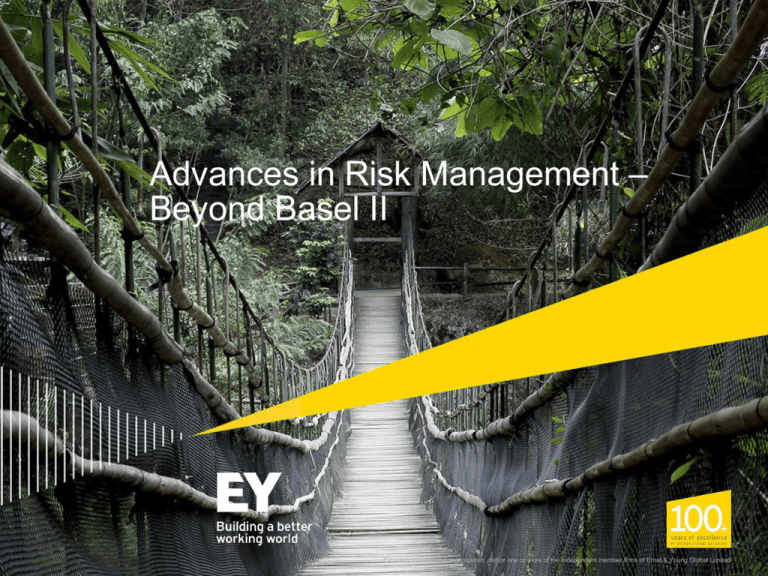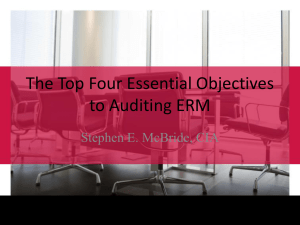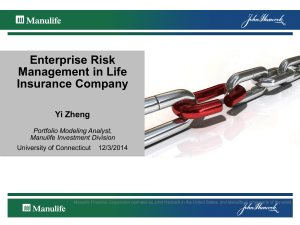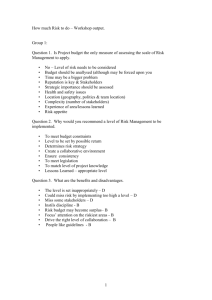
Advances in Risk Management –
Beyond Basel II
EY refers to the global organization, and/or one or more of the independent member firms of Ernst & Young Global Limited
Contents
About the Speaker
Pratik Shah,
Ernst & Young LLP, India
Partner- Advisory Services
Leader- Financial Services Risk Management
Associate Member of the Institute of Chartered Accountants, India, has a Masters of Business Administration from
Peter F. Drucker Graduate School
► Sixteen years of professional experience specialising in Governance, Risk & Compliance Assignments
►
►
1.
2.
1.
2.
3.
4.
Expertise:
Operational Risk
Credit Risk
Regulatory Compliance
Capital Management
Governance Risk
Enterprise Risk Management
►
1.
1.
2.
3.
4.
5.
6.
7.
Page 2
Key Markets
India
USA
UK
Australia
Switzerland
Singapore
Malaysia
Vietnam
►
1.
2.
3.
4.
5.
6.
7.
Key FS Clients
SBI Group
ICICI Group
Credit Suisse
ANZ
Morgan Stanley
GE Capital
Zurich Financial
Services
Contents
Content
1
Background and Context Setting
2
Integrated view of Risks
3
Using Risk Management to take Strategic Decisions
4
Linkage to Capital Management and Stress Testing
Boubyan Bank, Kuwait
3
Background and Context Setting
Page 4
What is ERM and Why do we need it
ERM in a risk-based approach to managing an enterprise, integrating risk management of Pillar 1 risks, Pillar 2
risks, internal control and strategic planning. It helps to manage risk to be within its risk appetite, to provide
reasonable assurance regarding the creation and protection of value for stakeholders.
“It would be a mistake to conclude that the only way
to succeed in banking is through ever-greater size
and diversity.
Indeed, better risk management may be the only
truly
necessary element of success in banking.”
Silo
risk management
Enterprise risk management
AlanSafeguard
Greenspan
Key focus:
Key focus: Maximize Enterprise
Enterprise Value
• Compliance focused
• Works with in the boundary of
definition
• Focuses on Risk Mitigation &
usually not fully aligned to
strategic & operational
decisions
Necessary but value addition is
limited to risk definition
Page 5
PRIVATE & CONFIDENTIAL NOT TO BE SHARED WITH THIRD
PARTIES WITHOUT PRIOR WRITTEN CONSENT OF EY
Value
• Value focused
• Comprehensive coverage of
risk universe (ex: Strategic,
model risk)
• Focuses on emerging risks
and core to strategic &
operational decisions
An organizational capability that
drives substantial value Vs
competes
Risk Appetite and Material risk assessment sets the tone for
fully functional ERM
ERM Component
Objective
Use
Risk Appetite: Risk Appetite is the
amount of risk, on a broad level, that
an organization is willing to take on in
a pursuit of its strategic business
objectives
• Drive range of business decisions
including resource allocation, new
business opportunities, liquidity
and capital planning by
incorporating risk perspective
• Improves the way risk is explicitly
considered when management
makes strategic decisions
• Helps establish meaning reports
for senior management and the
board.
• Provide focus to risk assessments
and stress testing.
Material Risk Assessment:: The
Integrated Material Risk Framework
provides the board and senior
management relevant information
concerning the Bank’s risk profile, in
a timely and concise manner.
Integrated Material Risk Assessment
is driven by:
Page 6
• Provide a top down approach to
obtain integrated view of risks
across the organization and
connect risk profile to approved
risk appetite
PRIVATE & CONFIDENTIAL NOT TO BE SHARED WITH THIRD
PARTIES WITHOUT PRIOR WRITTEN CONSENT OF EY
• Provices synthesized, actionable
risk dashboard: Drawn from reports
& documents used by top
management to provide insights
on past, present and future
ERM framework builds on Basel- II elements to facilitate the
risk informed business decisions
Vision, Guiding Principles, Stakeholder, Risk
Capacity
Business &
Financial
objectives
Identification
of metrics
Primary capital allocation
Setting risk-adjusted return on equity
Analysis of
resources &
constraints
Integrated view of risk
basis impact om risk
appetite
Market &
Competition
Performance
mgmnt
Re-allocation
• Performance Vs
original targets
•
Sub-allocation
– BU / Portfolio
• Portfolio reallocation
•
Performance
metrics
j
1
Risk Appetite
Metrics
KRI
2
Earnings, Capital, Reputation, Governance
Identify and measure indicators for each risk that impacts the risk appetite values
Risk
Quantification
1
Page 7
VaR ,CVA, PFE,PD, LGD, EAD CCF,ALM, EaR, BEICF score
Risk
Assessment
Market Risk
Credit Risk
Liquidity / IRR
Operational
Risk
Sources of
risk
Trading book
Banking book
Balance Sheet
Profit & Loss
Governance
Integration of risk an finance
2 Risk based performance management
PRIVATE & CONFIDENTIAL NOT TO BE SHARED WITH THIRD
PARTIES WITHOUT PRIOR WRITTEN CONSENT OF EY
Basel II
Framew
ork
Taking an Integrated view of risks –
Beyond Basel II
Page 8
Risk Appetite – Tool to align the risk the Bank takes is
aligned to the strategy
Objective
A practical and simple approach to facilitate financial and business planning through improved
returns
Attributes of Good Risk Appetite
Linked to Strategy
Comprehensive Coverage
►
►
►
Linkage to mid to long
term strategy
Benchamrked to Peers /
Competes
►
RAS should
comprehensively cover all
fundamental risks the
bank faces
Include quantitative and
qualitative statements
Govern Decision Making
►
►
Govern decision making
across all businesses and
risk types
Allocate group level risk
appetite to specific risk
categories, lines of
business, legal entities
etc.
Key Steps
Establish Risk Appetite
Identify risk and finance
metrics and define
tolerances for risk
appetite at bank level
Cascade Risk Appetite
Manage & Monitor
Integrate Risk Appetite into
major decisions such as
capital planning, budgeting,
liquidity planning
Establish monitoring
templates that are linked
to Risk Appetite but are
also relevant to Business
Units
Report & Escalate
Develop reporting
dashboards and action
tracking mechanism for
board and sr.
management
Driving Strategic Decisions on Capital Allocation through
Risk Appetite: Illustrative – RAROC
Risk Appetite
Implementation
Risk Adjusted Return on Capital (RAROC): Provides risk based profitability measurement
framework
for measuring risk
adjusted financial performance across the bank. It is calibrated down to business groups, portfolio and borrowers
Illustrative Risk Appetite Statement: The bank should target a risk adjusted return greater than the weighted average cost of
capital employed at all times (Hurdle Rate).
Risk Appetite Statement – Risk Adjusted Return on Capital (Illustrative)
Use test – Periodic monitoring and
update
Target RAROC > Hurdle Rate
20.00%
18.25%
18.00%
16.00%
• Target RAROC computed based on:
• Peer Group Benchmarking
• Hurdle rate - Cost of capital i.e capital
based on WACC plus liquidity premium
considered as minimum RAROC for the
bank
• RAROC Vs ROE i.e RAROC > ROE
indicates a significant capital buffer or
inefficient use of capital
• Constraints- capital adequacy, priority
sector – External; portfolio focus and
capability - Internal
Page 10
• Target RAROC embedded into
• Capital utilization
• Financial Projections – Asset
growth
rate,
portfolio
diversification
and
capital
generation rate
• Business Strategy- Focus areas
based on RWA composition i.e
Reduce percentage of Risk
Weighted Assets systematically in
order to improve ROA
PRIVATE & CONFIDENTIAL NOT TO BE SHARED WITH THIRD
PARTIES WITHOUT PRIOR WRITTEN CONSENT OF EY
14.00%
12.34%
12.07%
12.00%
10.10%
10.00%
9.97%
10.20%
9.67%
9.17%
8.00%
6.00%
4.00%
2.15%
2.00%
0.00%
0.71%
Bank 1
RAROC
Bank 2
Bank 3
Bank 4
Weighted Average Cost of Capital
Material Risk Assessment – Tool to distil information and provide
integrated view of top risks and big bets shaping Bank’s performance
Objective
Risks by nature are interdependent, major negative outcomes are usually due to convergent of risk factors , so
to measure the these converged impact on earnings, capital, liquidity and reputation and provide an integrated
Attributes of Good MRA framwork:
Risk/ Reward Tradeoff
►
►
►
►
Insight on Top risks
Clarity on big bets
Major decisions
supported with risk
insights
Risk dialogue with top
management
Increased Board Involvement
►
►
Top management
involved in risk
processes-Oversight
Critical risk information
surfaced in timely manner
Robust Risk Management
►
►
Exhaustive identification
and prioritisation of risks
Should contain forward
looking elements,
historical risk metrics may
not be good indictors of
duture
Key Steps
Identify Metrics
Finalize Metrics
Link to Risk Appetite
Identify material risks and
corresponding metrics
aligned to current risks
undertaken based on
strategy
Shortlist material risks
and metrics based on
management workshops
and data analysis
Determine thresholds
and categorize into low,
medium, high based on
Risk Appetite of the bank
and business strategy
Page 11
PRIVATE & CONFIDENTIAL NOT TO BE SHARED WITH THIRD
PARTIES WITHOUT PRIOR WRITTEN CONSENT OF EY
Assessment & Reporting
Collect data, perform
assessment based on
defined scales and report
results through integrated
risk dashboards
Material Risk Assessment – Illustrative view of risk
►
Risk Dashboard is a periodic snapshot of a top-down assessment of key risks facing the bank – it is presented by the
CRO to the Board of the Bank - impact assessment is based on multi-dimensions i.e., earnings, capital, people and
reputation – KRIs are used to track the trajectory of risk …
Impact
Rank
(Last)
Risk
Group
Likely
1
(x)
Credit Risk
Credit
High
2
(x)
Credit Concentration
Risk
Credit
High
3
(x)
Country Risk
Credit
Medium
4
(x)
Market Risk
Market
Medium
5
(x)
Liquidity Risk
Finance
Medium
6
(x)
Operational Risk
Operational
Medium
7
(x)
Compliance Risk
Operational
Medium
Page 12
Earnings
Capital
People
Reputation
Ear – H
Cap - M
Poe - L
Rep - L
Ear – H
Cap - H
Poe - H
Rep - H
Ear – M
Cap - M
Poe - L
Rep - L
Ear - M
Cap - L
Poe - M
Rep - M
Ear – M
Cap – M
Poe - L
Rep - H
Ear - L
Cap - L
Poe - H
Rep - M
Ear – M
Cap – L
Poe - M
Rep - M
PRIVATE & CONFIDENTIAL NOT TO BE SHARED WITH THIRD
PARTIES WITHOUT PRIOR WRITTEN CONSENT OF EY
Time
Horizon
Status
Owner
Action
Plan
Effective
NOW
↓
CRO
High
NOW
↑
CRO
Low
1 YEAR
↓
CRO
High
1 YEAR
↑
Treasury
Medium
NOW
↑
ALM
Medium
1 Year
↑
ORM
Low
1 Year
↑
Complia
nce
High
Risk Assessment and Reporting
Illustrative – Credit Risk
Definition
Credit Risk
• Credit Risk is the current and prospective impact on earnings and capital, arising from the loss to an entity due to inability or unwillingness of a borrower/counter-party to
borrower/counter-party to meet commitments in relation to lending, trading, settlement and other financial transactions or reduction in portfolio value arising from actual
portfolio value arising from actual or perceived deterioration in credit quality of borrowers/counterparties.
Name of the Entity: Bank xx
Key Risk Driver Description:
1. Percentage of unrated exposure to Total Credit Exposure
Exposure
2. Gross NPA to Gross Advances Ratio (%)
3. Total unsecured credit exposure as a % of Total Credit
Credit Exposure of Entity
4. Ratio of Risk Weighted Assets to Total Assets
5. Average DPD (xx days- YY days) as a % of Total Credit
Credit Risk Exposure
1
4
9
16
25
Entity Value
Assessment Rating
0-5
0-1
0-5
5-10
1-2
5-15
10-15
2-3
15-25
15-25
3-5
25-35
25 <
5<
35 <
12
2.4
26.4
9
9
16
0-40
40-50
50
2-4
50-60
60-70
70 <
63
16
4-6
6-8
8<
2.4
4
0-2
Overall Rating for Credit Risk (Average)
11
Key Performance Driver Description:
1. Actual vs Targeted Net Interest Income (Actual as a
as a percentage of Target)
85 >
Legend – Risk Index
1-7
Page 13
Low
85-90
90-110
Medium
110-125
8 - 14
125 <
High
PRIVATE & CONFIDENTIAL NOT TO BE SHARED WITH THIRD
PARTIES WITHOUT PRIOR WRITTEN CONSENT OF EY
112
15 - 22
16
Critical
> 23
Risk Assessment and Reporting
Illustrative – Credit Risk
Risk vs Performance Assessment Map
Legends
Risk is not commensurate with
the return generated
Risk is greater than return
generated
Risk is commensurate to the
return generated
Credit Risk
Unrated Exposure to Total Credit Exposure
15.00%
11.00%
10.00%
12.00%
9.00%
5.00%
0.00%
2012
2013
2014
Unrated Exposure to Total Credit
Exposure
Page 14
Gross NPA to Gross Advances
4.00%
3.00%
2.00%
1.00%
0.00%
2.90%
2.10%
2012
2013
Past Due Exposure to Total Exposure
2.40%
2014
Gross NPA to Gross Advances
PRIVATE & CONFIDENTIAL NOT TO BE SHARED WITH THIRD
PARTIES WITHOUT PRIOR WRITTEN CONSENT OF EY
2.50%
2.40%
2.30%
2.20%
2.10%
2.00%
1.90%
2.40%
2.20%
2.10%
2012
2013
SMA Exposure to Total Exposure
2014
Bringing ERM framework to life- An illustration – Credit Risk &
RAROC
Vision, Guiding Principles, Stakeholder, Risk
Capacity
Risk adjusted
Resources &
profitability
constraints:
and resource
- Cost of Capital
Metrics:
allocation
- Income &
RAROC
Volatility, risk
free return,
peer returns
Risk Profile
Primary capital allocation
Target risk-adjusted RAROC
Performance Management
business mix
- Reg capital /
provisions
Portfolio RAROC | Re-allocation |Capital
Optimization
j
1
2
Risk Appetite
Metrics
Capital - RAROC
•
KRI
•
•
•
Unrated exposure to Total Exposure
Gross NPA to Gross Advances
Past Due to Total Exposure
Interest Expended to Average Liabilities
Page 15
•
•
•
•
Negative
Negative
Negative
Positive
Risk Quantification
PD, LGD, EAD CCF
Risk Assessment
Basel II- Credit Risk
Source of Risk
1
RAROC Relationship
Banking book
Integration of risk an finance
PRIVATE & CONFIDENTIAL NOT TO BE SHARED WITH THIRD
PARTIES WITHOUT PRIOR WRITTEN CONSENT OF EY
Credit Risk
2
Risk based performance management
Bringing ERM framework to life- An illustration – Credit Risk
Vision, Guiding Principles, Stakeholder, Risk
Capacity
Integrated Risk Profile
Primary capital allocation
Business &
Financial
objectives
Setting risk-adjusted RAROC
Analysis of
resources &
constraints
Identification
of metrics
Performance Management
Integration of Risk and
Finance Data
Market &
Competition
• Allocation of Capital based on
performance of portfolios and BUs
• Portfolio re-allocation
• Capital Optimization
1
Risk Appetite
Metrics
Capital - RAROC
••
KRI
KRI
••
••
••
2
RAROC Relationship
Unrated
Unratedexposure
exposuretotoTotal
TotalExposure
Exposure
Gross
NPA
to
Gross
Advances
Gross NPA to Gross Advances
Past
PastDue
DuetotoTotal
TotalExposure
Exposure
Interest
Expended
Interest ExpendedtotoAverage
AverageLiabilities
Liabilities
••
••
••
••
Negative
Negative
Negative
Negative
Negative
Negative
Positive
Positive
Risk Quantification
PD, LGD, EAD CCF
Risk Assessment
Basel II- Credit Risk
Credit Risk
Source of Risk
1
Page 16
Banking book
Integration of risk an finance
PRIVATE & CONFIDENTIAL NOT TO BE SHARED WITH THIRD
PARTIES WITHOUT PRIOR WRITTEN CONSENT OF EY
2
Risk based performance management
ERM Framework impacts most business processes
Strategic
Planning and
Corporate
Strategy
Risk and
Performance
Reporting:
•
•
•
•
Manage expectations
Proactive Management
Risk Dashboards
Monitoring of KRIs / KPIs
Resource Management and
Product Approval
Strategy
Identification
Monitoring /
Disclose
Target
Setting
Strategy
Execution
• Efficient utilization of
capacity
• Identify acceptable and
unacceptable sources of
risk
Page 17
• Identify optimal mix of business
strategies
• Medium term aspirations
• Provide guidelines
• Assess Earnings implications of
strategies
• Outline best use of spare
capacity
Risk and
Performance
Measurement
• Calculate Economic
Capital, RAROC/ EVA
• Calculate EaR
• BU cascading of limits
• Maintain Desired Profile
Target Evaluation and
Portfolio Management
• Execute contingency
planning
• New Business
Opportunities
PRIVATE & CONFIDENTIAL NOT TO BE SHARED WITH THIRD
PARTIES WITHOUT PRIOR WRITTEN CONSENT OF EY
Using Risk Management to take Strategic
Decisions – Case: Capital Management
Page 18
RAROC based capital allocation
𝑹𝑨𝑹𝑶𝑪
𝑰𝒏𝒕𝒆𝒓𝒆𝒔𝒕 + 𝑭𝒆𝒆 𝑰𝒏𝒄𝒐𝒎𝒆 − 𝑰𝒏𝒕𝒆𝒓𝒆𝒔𝒕 𝑬𝒙𝒑𝒆𝒏𝒔𝒆𝒔 − 𝑶𝒑𝒆𝒓𝒂𝒕𝒊𝒏𝒈 𝑬𝒙𝒑𝒆𝒏𝒔𝒆𝒔 − 𝑬𝑳
=
𝑹𝒆𝒈𝒖𝒍𝒂𝒕𝒐𝒓𝒚 𝑪𝒂𝒑𝒊𝒕𝒂𝒍
Expand business and allocate capital only in those geographies/
sectors/ borrowers who can match the target return , which is
determined by the Bank through WACC and other mark - ups
Step 2: Determine Target Risk Premium above base rate
Step 1: Determine Target Return
Cost per Rupee Exp
Risk Appetite
Segment
Determine
Bank-wide
cost of
capital
(WACC)
Determine
Target
Return (%)
for the
balance
portfolio
Determin
e Bankwide
Target
Return
(%)
Add the mark-up to factor in
overall spread / margin that
the bank targets to achieve
Add the mark-up to factor in
discounts on Priority Sector
DRI, staff loans, etc.
Interest
Operating
Capital %
Provisions
Trend of
Interest
Income
(%)
Corporate
BBB )
Corp- (below
Base
Rate
(%)
Target Risk
Target Income
Premium
(%) to meet
above base
Target Return
rate
1.00%
2.00%
XX PSE
%
MSME –
Guaranteed
MSME no
guarantor
Home loan
0.25%
Other Retail
3.50%
3.00%
4.00%
2.00%
….
Yes
Allocate
Capital Prioritize
growth
No/Less
Allocation
Page 19
Reduce
required
Regulatory
Capital
Yes
No
Can charge
premium to
the
customer?
Guarantee
s
Collateral
Ratings
On-BS
Netting
No
Can charge
premium to
the
customer?
Step 3: Take Capital Allocation
Decisions
PRIVATE & CONFIDENTIAL NOT TO BE SHARED WITH THIRD
PARTIES WITHOUT PRIOR WRITTEN CONSENT OF EY
Apply market
constraints,
competitor
pricing,
relationship /
strategic
portfolio
constraints
Enable senior management monitoring of capital efficiency
across the bank
Cost
Region
Interest
Operating
Provisions
Capital
Required
Interest
Target
Income (%)
Return (%)
Segment Capital Efficiency Dashboard
Segment
Exposure
RAROC
Target Return
(%)
NPA
(%)
Avg. RW
(%)
Overall Bank
RM dept.
•
•
Monitor the
Capital
Efficiency
across the
bank, follow up
with braches,
BUs
Mumbai
Corporates
Delhi
SME
Chennai
Retail –
Personal
Hyderabad
Region Avg.
Pune
Granular analysis for segments where returns are
below the target returns
Reporting of
key metrics to
Senior
Management
Templates
provided
for RAROC
based
capital
allocation
would
form an
input to
the MIS
EY will develop MIS dashboards for the senior management for strategic decisioning to target/exit
portfolios – geographies, products , industries, etc.
Page 20
PRIVATE & CONFIDENTIAL NOT TO BE SHARED WITH THIRD
PARTIES WITHOUT PRIOR WRITTEN CONSENT OF EY
Senior
Management
•
Analyze the
overall Capital
Efficiency metrics
within the Bank
•
Drive strategic
decision making
•
Support IRM in
prioritizing and
rolling out key
initiatives
EY | Assurance | Tax | Transactions | Advisory
About EY
EY is a global leader in assurance, tax, transaction and advisory services.
The insights and quality services we deliver help build trust and confidence
in the capital markets and in economies the world over. We develop
outstanding leaders who team to deliver on our promises to all of our
stakeholders. In so doing, we play a critical role in building a better working
world for our people, for our clients and for our communities.
EY refers to the global organization, and may refer to one or more, of the
member firms of Ernst & Young Global Limited, each of which is a separate
legal entity. Ernst & Young Global Limited, a UK company limited by
guarantee, does not provide services to clients. For more information about
our organization, please visit ey.com.
The MENA practice of EY has been operating in the region since 1923. For
over 90 years, we have evolved to meet the legal and commercial
developments of the region. Across MENA, we have over 4,200 people
united across 18 offices and 13 Arab countries, sharing the same values
and an unwavering commitment to quality.
© 2015 Ernst & Young
All Rights Reserved.
This publication contains information in summary form and is therefore
intended for general guidance only. It is not intended to be a substitute for
detailed research or the exercise of professional judgment. Neither EYGM
Limited nor any other member of the global EY organization can accept any
responsibility for loss occasioned to any person acting or refraining from
action as a result of any material in this publication. On any specific matter,
reference should be made to the appropriate advisor.
ey.com/in






